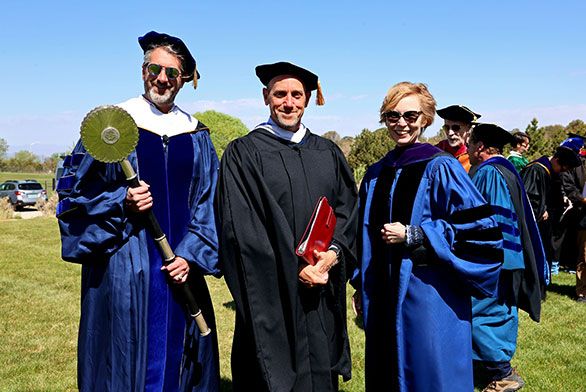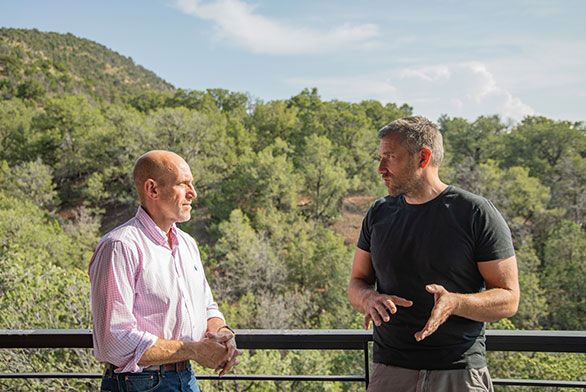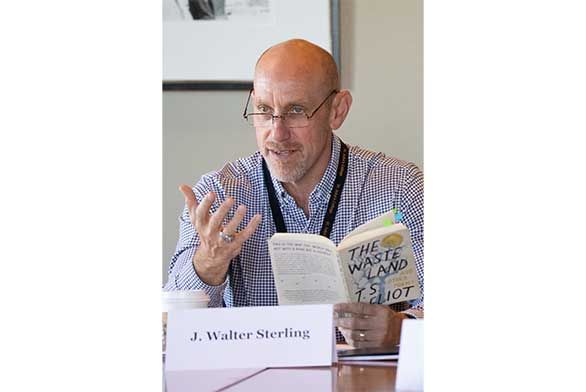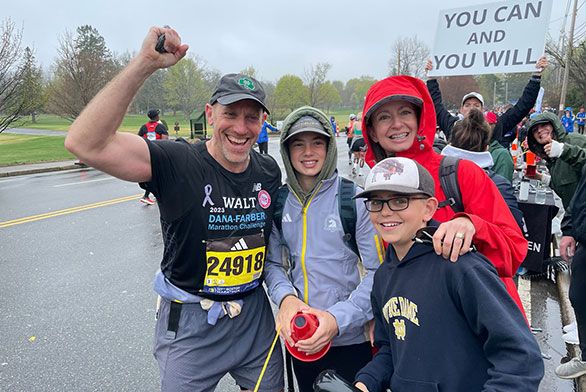Keeping Up with Santa Fe President J. Walter Sterling
August 13, 2024 | By Kirstin Fawcett (AGI26)
J. Walter Sterling (A93) enjoys being challenged. In 2006, three years after joining St. John’s College as a tutor, he participated in his first Ironman Triathlon: a 2.4-mile swim followed by a 112-mile bike ride and a 26.2-mile run. After a 15-year break, he completed three more in three years, and the last was his fastest. “Our freshmen translate the Greek saying, ‘noble things are difficult.’ It doesn’t mean all difficult things are noble,” Sterling jokes, “but still, I think about that all the time and take inspiration from it.” This competitive “agonistic” mentality also informs his professional vocation: “I’m confident that the best days of the college are ahead of us,” he says.

Sterling, a St. John’s graduate who studied on both campuses, assumed the Santa Fe presidency this summer following Mark Roosevelt’s retirement. True to form, the longtime educator, former dean of the college, and now veteran triathlete hit the ground running. This fall marks a busy semester for St. John’s Santa Fe, but Sterling is looking far into the future, strategizing how to best position the campus for long-term success while staying true to its enduring mission of “freeing minds.”
“I do have deep roots at the college,” says Sterling, whose parents are both alumni and whose father is Annapolis tutor emeritus Walter Sterling. “That’s certainly a big part of how my life has been interwoven with the college and why I care about this work and this community. But as president, I’m truly looking at the college with fresh eyes: what inspires our community today, and how will we grow and evolve tomorrow.”
Sterling says that success in the next chapter includes strengthening the college’s regional roots. New Mexico, in addition to its rich cultural heritage and natural beauty, boasts more Johnnies per capita than any other state: around 1,700 and counting, with 1,000 residing in the Santa Fe area alone. Sterling, a longtime Santa Fe resident, is raising two sons here with his wife Meghan. “The best math teacher they are ever likely to have at any level is a Johnnie who taught both my sons in middle school in the Santa Fe Public Schools,” Sterling says. “I am proud of how many Johnnies are educators in this state and of the impact of the Tecolote program that has brought so many K-12 teachers to our campus for immersion in St. John’s seminars.”

Sterling felt privileged to serve as dean through the $325 million Freeing Minds capital campaign, which gave rise to the Pritzker Challenge Grant for Campus Improvements. A renovation of the Peterson Student Center (now the Pritzker Student Center) is currently underway; when completed in Fall 2025, it will include a welcoming, more integrated café and bookstore and new spaces for studying and socializing, while preserving the building’s treasured architectural features and Alexander Girard artworks.
Visitors can also marvel over the school’s new solar array—another transformative project funded by the Freeing Minds campaign, as well as the Class of 2019. The solar project houses a combined total of 1,670 photovoltaic panels. The installation is capable of generating 100 percent of the campus's electricity needs. And the college’s regional investments extend beyond the campus.
“We have committed to funding one qualified internship for every undergraduate,” Sterling says. “Our goal is to combine the very best career preparation with the very best liberal education, period. That addresses the greatest perceived obstacle to those who would otherwise choose this education, and generous philanthropic support is allowing us to make spectacular progress toward that goal.” More internships are being developed as local and regional partnerships; for example, St. John’s recently reached agreements with the City of Santa Fe and the State of New Mexico’s Department of Cultural Affairs to provide funded internship opportunities for interested undergraduates.

Honoring campus and alumni traditions along with geography is also key for Sterling going forward. St. John’s Santa Fe celebrates the 60th anniversary of its founding this October. The Dean’s Office will be hosting events throughout the academic year—lectures, panels, gallery exhibitions, and seminars—honoring the campus’s history. Santa Fe Homecoming is also slated for a comeback on the weekend of September 13-15, much to Sterling’s own excitement. “For many reasons, Homecoming was suspended since the pandemic hit,” he says. “Many folks at the college—and especially our alumni—have advocated for a return of a full Homecoming, to which all alumni are invited. I hope many will join the celebration either here or in Annapolis.”
Meanwhile, as much of academia slows down mid-summer, life on the Santa Fe campus has been busier than ever for Sterling. “It was wonderful to enter this office in July,” he says. “There’s no time of year when we have more visitors and guests engaged in St. John’s programs: the Summer Academy for high school students and Summer Classics for lifelong learners are such robust communities of learning. And after recovering from the pandemic disruption, we’re so excited to be near or above historic peaks of participation. With our January Freshmen and Graduate Institute students, the campus really comes to life in an extraordinary way. It’s especially energizing for me as president to have a chance to welcome and engage with these groups, and to hear from them what makes their time at St. John’s Santa Fe so special.”
Sterling himself recently took the opportunity to return to the seminar table, co-leading a Summer Classics seminar with Annapolis tutor Emily Langston on T.S. Eliot’s The Waste Land. In a polarized world that grows increasingly divided by technology and political strife, Sterling—now a college president, but first a tutor—has recently gained “an even greater sense of purpose and energy towards what we do at St. John’s,” he says.

“What happens in those seminars with lifelong learners is as rich and powerful and transformative as what we do in our degree programs,” Sterling reflects. “And again, it’s as vital as ever. The excitement and seriousness that those participants bring to the Program show us the acute need for this kind of dialogue and conversation and connection, a need poignantly felt in society—I truly believe—more so than in 1937, more so than in 1964, perhaps more so than ever before.”
For these reasons, he says “supporting and growing the Program,” is his most important focus. This, not unlike an Ironman Triathlon, is a daunting task requiring multiple strengths. “The fundamental role of the St. John’s president is to allow this community of learning to realize its mission and vision as well as possible. That touches everything, but primarily the president is trying to put the material conditions in place—the financial support, whatever other resources are needed—while publicly advancing the institution and our vision. We always need to make the best case for liberal education. Why should friends, donors, neighbors, and politicians want to support and invest in it? The future is not promised to us. We have to work for it, fight for it.”
Sterling sees in the contemporary challenges the seeds of many more future Johnnies. “What our society is experiencing right now—technologically and politically—is very different than just 10-15 years ago. I truly believe that our vision is increasingly compelling: a real conversation, with a real face across the table, and a tangible unhackable book, as a deep and renewing source that will hold your attention, not fragment it. It is not about rejecting technology. It’s about what the technologists of the future will need as much as everyone else: durable, deep humanism. I think it’s the most promising moment for liberal education in my lifetime, and St. John’s and our many friends and allies have a responsibility to hold fast and help lead the way out of the whirlwind that’s engulfed us.”

